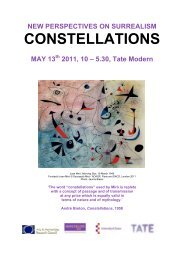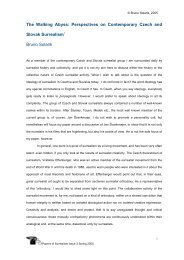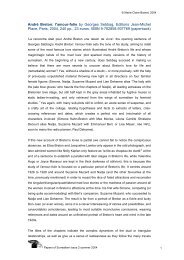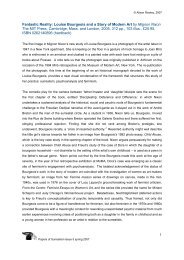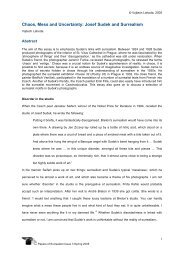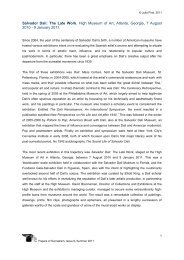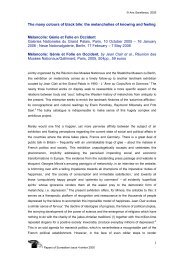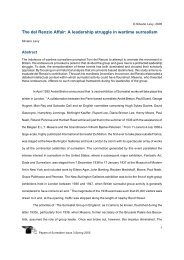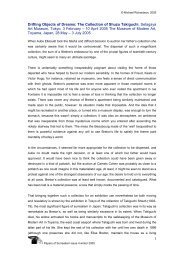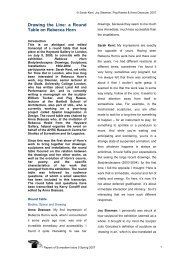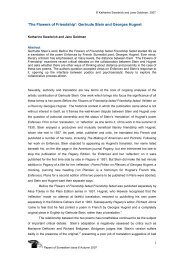From the Walls of Factories to the Poetry of the Street: Inscriptions ...
From the Walls of Factories to the Poetry of the Street: Inscriptions ...
From the Walls of Factories to the Poetry of the Street: Inscriptions ...
You also want an ePaper? Increase the reach of your titles
YUMPU automatically turns print PDFs into web optimized ePapers that Google loves.
© Caroline Levitt, 2011<br />
The first two letters <strong>of</strong> <strong>the</strong> word that describes <strong>the</strong> added object complete <strong>the</strong> word that precedes it, a pun<br />
that fortui<strong>to</strong>usly also works in English:<br />
Madame<br />
You appeared <strong>to</strong> me for <strong>the</strong> fir<br />
[s<strong>to</strong>at]<br />
The reader is left <strong>to</strong> substitute <strong>the</strong> end <strong>of</strong> <strong>the</strong> word „ermine‟ or „s<strong>to</strong>at‟ for <strong>the</strong> missing word, „fois‟ or<br />
„time.‟<br />
Apollinaire views <strong>the</strong> rebus that leads him <strong>to</strong> Ernest la Jeunesse as powerful, distinct from <strong>the</strong><br />
insignificant puzzles found in contemporary newspapers, and descending from a tradition <strong>of</strong> hidden<br />
meanings both for <strong>the</strong> sake <strong>of</strong> secrecy and for <strong>the</strong> sake <strong>of</strong> <strong>the</strong> illiterate. Apollinaire refers <strong>to</strong> <strong>the</strong> letters<br />
on <strong>the</strong> paper as „signs,‟ a reminder that writing is at base simply a visual means <strong>of</strong> communicating<br />
meaning. An apparently insignificant piece <strong>of</strong> paper inscribed with a significant combination <strong>of</strong> signs<br />
thus has <strong>the</strong> power <strong>to</strong> change <strong>the</strong> course <strong>of</strong> Apollinaire‟s day and <strong>to</strong> lead him <strong>to</strong> a meeting with <strong>the</strong><br />
Symbolist author with whom he would remain acquainted until his death in 1917 from cancer, as we<br />
learn in <strong>the</strong> latter part <strong>of</strong> Apollinaire‟s narrative.<br />
The scrap <strong>of</strong> paper described in Le Flâneur would perhaps have been considered valueless<br />
and left <strong>to</strong> float in <strong>the</strong> wind by someone o<strong>the</strong>r than Apollinaire, yet it turns out <strong>to</strong> be <strong>of</strong> great<br />
significance, leading him in<strong>to</strong> an apparently real but ra<strong>the</strong>r strange and unexpected series <strong>of</strong> events.<br />
In Mes Prisons, discussed at <strong>the</strong> start <strong>of</strong> this article, <strong>the</strong> only potential writing surface <strong>to</strong> hand (a list <strong>of</strong><br />
prison rules) had apparently been taken from its mundane purpose, used for <strong>the</strong> writing <strong>of</strong> a poem,<br />
and <strong>the</strong>n left <strong>to</strong> chance in <strong>the</strong> cell, <strong>to</strong> be found almost six months later, coincidentally by a poet, and<br />
<strong>the</strong>n published in a newspaper. Whe<strong>the</strong>r <strong>the</strong>se anecdotes are factual or fictive, <strong>the</strong> values <strong>of</strong> objects<br />
and <strong>of</strong> creativity are thus questioned and <strong>the</strong> status <strong>of</strong> objects fluctuates, being one moment<br />
apparently valueless, everyday and ephemeral, but <strong>the</strong> next valuable, notable and preserved. Such is<br />
<strong>the</strong> status <strong>of</strong> graffiti and this oscillation was essential <strong>to</strong> <strong>the</strong> surrealists‟ concept <strong>of</strong> <strong>the</strong> marvellous.<br />
Found, ephemeral traces can, <strong>the</strong>n, be on <strong>the</strong> one hand playful and on <strong>the</strong> o<strong>the</strong>r hand<br />
significant in more pr<strong>of</strong>ound ways. When Aragon wrote <strong>of</strong> „hieroglyphs on <strong>the</strong> walls‟ and claimed <strong>the</strong><br />
words on everyday objects <strong>to</strong> be as important as „<strong>the</strong> inscriptions <strong>of</strong> a book <strong>of</strong> black magic,‟ he both<br />
recognised <strong>the</strong> same power that Apollinaire had found in linguistic fragments and anticipated <strong>the</strong><br />
magical or talismanic properties that Brassaï would also see in graffiti, relating it <strong>to</strong> both cave art and<br />
psychological cures:<br />
Everything is magical for <strong>the</strong> child … fairies, devils, monsters are for him so real that he is<br />
scared <strong>of</strong> <strong>the</strong>m … Art alone can exorcise <strong>the</strong>se phantasms. For it is indeed <strong>the</strong> power <strong>of</strong><br />
magic that is at <strong>the</strong> origin <strong>of</strong> <strong>the</strong> power <strong>of</strong> art. To trace a line, a figure, gives <strong>to</strong> <strong>the</strong> child a<br />
sense <strong>of</strong> power and domination that belongs only <strong>to</strong> <strong>the</strong> magician. It is only through art that he<br />
can bend <strong>the</strong> world <strong>to</strong> his will … <strong>the</strong> power that <strong>the</strong> prehis<strong>to</strong>ric hunter wanted <strong>to</strong> exercise on<br />
his game by tracing its „simulacrum‟ at <strong>the</strong> back <strong>of</strong> caves still works on walls <strong>of</strong> ano<strong>the</strong>r type. 48<br />
The concept <strong>of</strong> <strong>the</strong> artist as magician goes back <strong>to</strong> Romanticism, and <strong>the</strong> notion <strong>of</strong> art as simulacra or<br />
effigy emulates Freud‟s description <strong>of</strong> magic in „primitive‟ cultures in Totem and Taboo (1913). 49 In<br />
this sense, we might suggest that a wall full <strong>of</strong> graffiti is effectively a wall <strong>of</strong> simulacra that might<br />
function much as <strong>the</strong> voodoo doll: „for <strong>to</strong> act on <strong>the</strong> simulacrum is <strong>to</strong> act on <strong>the</strong> person <strong>the</strong>mselves.‟ 50<br />
Papers <strong>of</strong> Surrealism, Issue 9, Summer 2011 17




